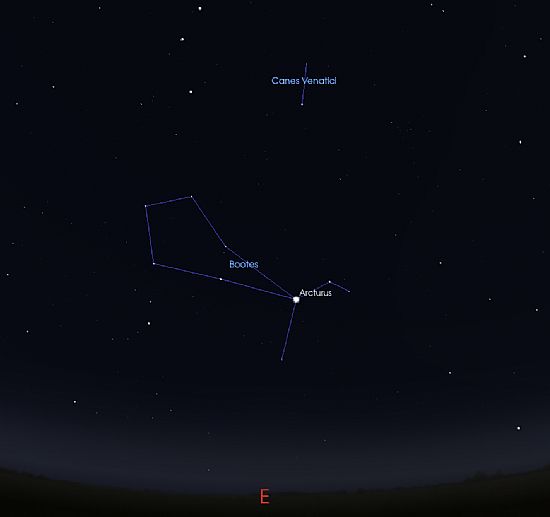Weekly Binocular Objects
WBO 10: 2018 Week 14 (5th Apr) - Messier 3 (NGC5272)
This time we’ll introduce a new type of deep sky object - globular clusters. These are very tightly packed groups of usually fairly old stars, held together by their combined gravitational attraction. Our target is the globular cluster Messier 3 (M3), in the constellation of Canes Venatici currently in the Eastern sky. Although M3 lies in Canes Venatici, the cluster is quite far from the principle stars of this small constellation, so we’ll also use the constellation of Bootes and its alpha star Arcturus to help us locate the globular cluster.
Looking to the East at around 21:30 BST, you should be able to easily spot a bright white star low in the sky - this is Arcturus, the brightest star in Bootes. Image 1 shows the wide view to the East, along with Arcturus and the constellation of Bootes. What of Canes Venatici then? Well it might be the least impressive of all constellations - a simple line of two stars! This small constellation is shown in Image 2, a little way above Bootes and Arcturus, and may take a short time to locate and identify in the sky. Our target cluster, M3, lies approximately half way between Arcturus and the lower star of Canes Venatici (Cor Caroli) as shown in Image 3. For the average binocular, M3 will be around two complete fields of view above Arcturus, providing an alternative method of location. If you’re having trouble, try slowly scanning the area between Arcturus and Cor Caroli until you happen upon the cluster - it’s a relatively bright object so shouldn’t be too tricky to see.
Having found the cluster, Image 4 shows an approximation of what you’ll see with a typical 10x binocular. As the name suggests, globular clusters are roughly spherical collections of stars, and you should be able to discern a strong concentration of stars towards the center of the cluster. This object can benefit greatly from increased observing time, so pull up a chair and relax as you take in the view. After a while, you may be able to pick up some very slight speckling around the edges as you begin to resolve individual stars, though this can be very dependent on sky conditions. Globular clusters tend to look best in telescopes where magnifications in excess of 100x are usually used, but the binocular view can be spectacular in a different way; the wide field of view provides a sense of context and allows us to better understand its location, whilst also giving a sense of the immense size and distance. M3 contains around 500,000 stars spanning 180 light years across, and lies around 34,000 years from Earth. As with many globular clusters, it is also fairly well established - around 8 billion years old.
The Moon is well out of the way this week, so shouldn’t affect observations of this globular cluster. As a final challenge, if you happen to have access to a reasonably dark sky, see if you can spot M3 without optical aid - at magnitude 6.2 it is within naked eye range, providing sky conditions are good and light pollution is low.
(all images from Stellarium - www.stellarium.org )

Image 1: Locating Arcturus and Bootes in the East

Image 2: Locating Canes Venatici

Image 3: Locating target cluster Messier 3

Image 4: Simulated binocular view (10x) centered on Messier 3